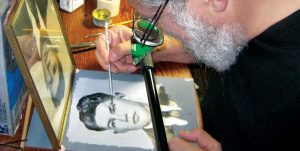
 The works of 17th-century Dutch painter Johannes Vermeer continue to confound modern art lovers. His uncanny ability to capture the nature of light is unparalleled; many consider it nearly impossible for someone living in the 1600s. And the mystery of Vermeer's talent extends still deeper: x-rays of his paintings show no sketching or guidelines under the paint. So how was Vermeer able to make such photorealistic works?
The works of 17th-century Dutch painter Johannes Vermeer continue to confound modern art lovers. His uncanny ability to capture the nature of light is unparalleled; many consider it nearly impossible for someone living in the 1600s. And the mystery of Vermeer's talent extends still deeper: x-rays of his paintings show no sketching or guidelines under the paint. So how was Vermeer able to make such photorealistic works?
That question is the driving force of the documentary "Tim's Vermeer". The film's subject, Tim Jenison, has already accomplished more in a lifetime than many of us could dream of. A pioneer of early computer programming, Jenison and his company NewTek still find themselves on the cutting edge of digital development. But Jenison does have one special interest outside of the modern world, and that is Johannes Vermeer. As an inventor, Jenison naturally wants to know how all things work; but he particularly wanted to know what techniques Vermeer could have used to create his realistic paintings. Using his ingenious mind, Jenison formulated a simple but brilliant technique that could have easily existed in the 17th century, using lenses to achieve the high level of intricate detail. Then, with no background in painting, he began his attempt to paint his very own Vermeer.
Jenison's quest to recreate a Vermeer was cataloged by Penn Jillette and Raymond Teller, better known as the magic duo Penn & Teller. Though Teller is credited as director, it was a conversation between good friends Jenison and Penn that sparked this project. From the start, the magicians knew they didn't want the movie to be about them making a movie, and though Penn does offer narration and appears in the film, this is without a doubt Tim Jenison's story. A fascinating man that could probably have 10 documentaries made about his life, Jenison still manages to come across as an average Joe -- wealth and genius aside. That's fortunate, as if he weren't so easily likeable, "Tim's Vermeer" would probably feel like a vanity project. Who wants to watch a bunch of rich friends document their own highfalutin hobby? Luckily, the film doesn't feel that way: there is much joy in watching Jenison reach for his dream.
There also is a deeper question at the heart of "Tim's Vermeer": why should art and technology be forced to remain separate from one another? Some claim that, had Vermeer in fact used a lens to guide his paintings, it would have been cheating -- mere "tracing". But others note that when painters sketch on their canvases first, they are using geometry to help them; geometry requires formulas, and since the formulas are public knowledge, technically anyone can use them. Does that make it cheating? Is the only "true" artistic painting one that is created without guidelines, either by sketches or by using a physical apparatus? "Tim's Vermeer" seems to suggest that by merging technology with art, we could open up a whole new avenue of creativity.
Editor Patrick Sheffield had his work cut out for him, as Teller brought him over 2,400 hours of raw footage to sift through to make "Tim's Vermeer". The result is an astonishingly brief 80 minutes that is funny, informative, and entertaining. At one point, Jenison remarks that the whole process is like watching paint dry. The product we get to watch is a hell of a lot more interesting.